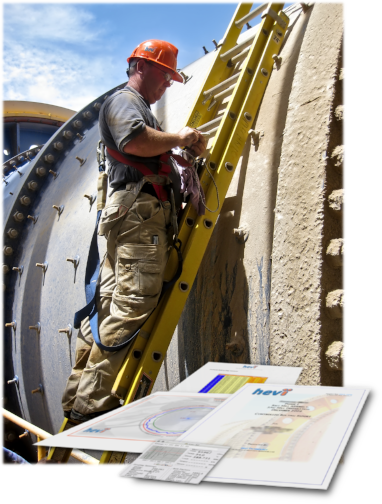mill availability.
monitoring and corrective adjustments of critical flange bolts

the issue: gradual loss of clamp load
Mill bolts operate in an arduous dynamic environment. Bolt loosening and load migration are often inevitable under such conditions. In the early years of a mill's life it isn't unusual to find up to 2-3 % of the total fastener population requiring re-tightening to return them to within the OEM’s carefully-determined tolerances.
*As many owners have experienced, merely re-torquing critical fasteners is ineffective since “torque” is a grossly misleading indicator of bolt clamp load.
the impact: production interruption …and worse
Flanges - Fastener loosening can result in more than just costly production nuisances; Long before loosened bolts fail in fatigue, the resulting slight flange separation promotes erosion as slurry begins to wash out the joint. Not only does this compromise flange integrity, it can start a cycle of repeated bolt failure and ever-growing distortion. In extreme cases, some owners have had to resort to complete shell section replacement before they could again experience uninterrupted production.
Girth Gear - Out-of-tolerance Girth Gear fastener “tightness” can result in run-out changes even if the gear slips only slightly relative to the shell. The resultant change in alignment places excessive levels of stress on both gear and pinion teeth leading to either reduced gear life or, to catastrophic tooth failure and immediate shutdown.
Liners - Liner bolts fail for a number of reasons. One key cause is uncontrolled-tightening during initial liner installation and then during re-torques. Blind torquing at best, or wild beating with impact tools at worst simply cannot achieve accurate tightness.
the solution: bolt load monitoring and corrections
Predictive rather than Reactive. Regular inspection of fastener stress values is necessary to identify and correct insufficient bolt clamp load before these conditions lead to forced shutdown. Drawing upon almost 30 years of experience in this unique field, hevii provides qualified Bolted Joint Control Technicians for independent Third Party preventative and, in late cases, remedial “Check and Tune” interventions. These specialist Technicians, using sophisticated devices to accurately determine as-is fastener stress, compare these values to the OEM’s specified requirements. Any fasteners found to have relaxed to below the safe tolerance limits are then “tuned” accordingly by applying the commensurate correction. In addition, since the equipment used is ultrasonic-based, hevii’s Technicians can often detect at-risk fasteners even if their clamp load remains within tolerance.
On-site Verification. Our speciality.

